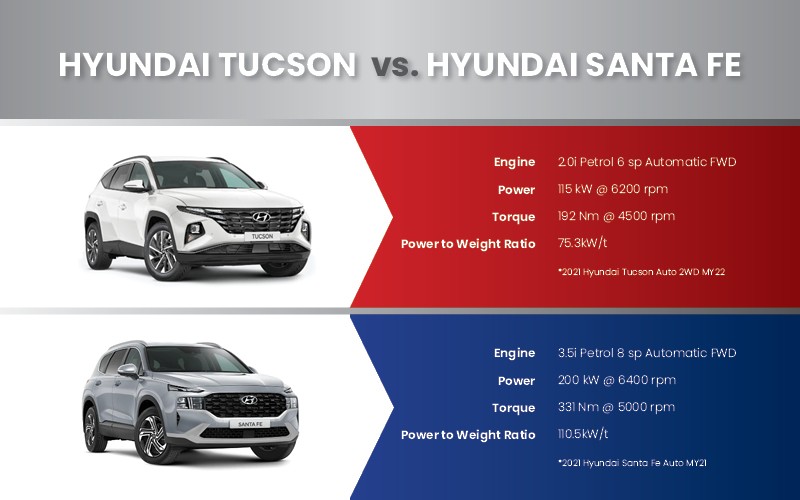
2021 Hyundai Tucson vs Hyundai Santa Fe
The Hyundai Tucson, and its big brother, the Santa Fe, are both impressive vehicles in their class. The 2021 versions benefit from additional features and exterior makeovers when compared with 2020. Many of the features that are characteristic of the Hyundai focus on luxury and performance are found in both models.
The key question for buyers is whether the extra cost of the Santa Fe is justified by the added value it provides. Here we take a look at the similarities and differences between the two, highlighting the areas where the Santa Fe has the edge.
In addition, we consider what type of driver is likely to find one model preferable over the other.
The Basics
For 2021, the Santa Fe's exterior has received a makeover. Additional safety features, as well as some intriguing pieces of tech, adding considerable value to the driving experience.
In comparison, the Tucson has also had its own makeover for 2021, featuring a much sportier exterior and an internal revamp. The result is a fast, sporty car that can hold its own on rougher roads as well as being ideal for urban driving.

Interior
The key difference between the two vehicles is the size of the cabin. Whilst the Tucson is a five-seater, the Santa Fe is designed as a seven-seater. When not in use, the third row in the Santa Fe can fold down to increase the boot space.
Both interiors are well laid out. Driver and passenger seats feature integral temperature control to optimise the driving experience. A 10.5" infotainment screen and digital dash come as standard in both models. Leather upholstery accents are available on the higher-spec models.
Drivers are able to utilise front and rear parking sensors, wireless phone charging and active cruise control.
Higher spec models of the Santa Fe and the Tucson have a large, panoramic sunroof. This adds to the interior experience but does mean that taller people in the second row will struggle with the seat height.
Reviewers note that the third row of seats in the Tucson isn't particularly spacious. Taller people will find the seats too compact for all but the shortest of journeys. Concerns around airbag positioning may also deter parents from using the third row for their children.
Exterior
Sporty or sportier? That's the main distinction between the Santa Fe (sporty) and the Tucson (sportier). The introduction of the Tucson's N-line package provides the opportunity to transform the exterior into a darker, moodier version of the standard vehicle.
The Santa Fe benefits from a similar shape to the Tucson, albeit larger. It features a sunroof, auto LED headlights, 20" alloys and a snappy reflector strip across the back bumper. The bold, striking exterior makes a powerful statement, backed by formidable performance.
Performance
In terms of torque and power output, the Santa Fe has the edge. The 2.2l diesel Santa Fe generates 148kW and 440Nm of torque. The petrol 3.5l offering comes in at 200kw and 331Nm of torque.
In comparison, the top-spec Tucson can only offer 400Nm of torque. The larger vehicle needs more power to achieve the same level of acceleration. On the road, there isn't that much difference between the two.
The transmission is an 8-speed shift-by-wire in the Santa Fe and 6-speed in the Tucson. Both receive favourable reviews.
The Santa Fe's diesel version is the most fuel-efficient, with an average usage of around 6.1l/100km. This narrowly beats the diesel Tucson, which averages around 6.3l/100km. The petrol variants of both the Tucson and the Santa Fe are far greedier, coming in at around 7.8l/100km and 10.5l/100km respectively.
Reviewers comment favourably on the handling of both vehicles. Hyundai has incorporated different driving modes for a variety of terrains (snow, mud and sand). Drivers can also choose from a variety of driving styles (eco, sport, comfort and smart) in both SUVs. Both share the Hyundai reputation for reliability, as well as the generous servicing package (5 years or 100km).
Highlights
Both vehicles are safe. They are equipped with Hyundai's suite of autonomous safety technology (Smart Sense). Features include AEB, lane assist, blind-spot monitoring, stability and traction controls and ABS.
The result is that both SUVs are safe choices. Airbags, ISOFIX points and top tether mounts are available in both Hyundai’s. The only slight concern for third-row Santa Fe passengers is that the curtain airbag doesn't extend back far enough to protect them.
The Santa Fe's remote parking system is a stunning feature that comes into its own in tight, urban car parks. All passengers and the driver can leave the vehicle before it is remotely manoeuvred into a tight parking space.
The key fob is deployed to act as a remote control. This is a fantastic innovation, particularly if you use car seats. It's also perfect for occasions where adults would have problems squeezing out of the vehicle due to a tight parking space.
If you value a plush, high-end interior, these Hyundais are both strong contenders. The manufacturer has worked hard to establish a reputation for using premium materials and high-quality workmanship to create interiors that are a joy to spend time in: the Santa Fe and the Tucson showcase this admirably.
Why You Should Buy The Tucson
The Tucson is an excellent all-rounder that can handle everything from the school run to an out-of-town adventure with equal ease.
Spacious, fuel-efficient and pleasant to spend time in, it's designed with the typical SUV user in mind. As well as benefiting from features that appeal to drivers (the digital instrument screen, Apple CarPlay and Android Auto compatible infotainment screen and temperature-controlled driving seat, for example), the Tucson also provides an appealing experience for passengers and has plenty of space.
The second row of seats is fine for two passengers but cramped for three. The rear doors don't open as wide as some other models, making car seat use a challenge at times.
Overall, there is little to criticise about the Tucson: in general, it's an SUV that provides excellent value and performance.
Read Our Complete Review Of The 2022 Hyundai Tucson
Why you Should Buy The Santa Fe
If size matters, the Santa Fe delivers! The third row of seats enables seven passengers to be transported, which is ideal for larger families.
The diesel variant offers excellent fuel efficiency, without compromising on performance and handling. Edgy to look at and with a beautiful interior, this is a midsize SUV that is definitely easy on the eye.
The tech is as good as most other vehicles in a similar class. The remote parking feature is particularly appealing.
Ideal for shorter trips with a larger number of passengers, this is also a car that appeals to drivers.
See The Top 7 SUV's in Australia for Families
Final Verdict
Ultimately, aside from the number of passenger seats, there isn't that much to differentiate between the Tucson and the Santa Fe - except when it comes to the price. The Santa Fe starts at around $44,700, up to $65,200 for a top-of-the-range version. The Tucson starts at about $30,990, going up to $54,341.
It's debatable whether the Santa Fe provides the added value needed to justify the significantly higher price. If you don't need the additional seating and can live without the remote parking feature, it may well be worth looking seriously at the Tucson for your next vehicle.
Find a Hyundai Tucson or Santa-Fe on OnlyCars.com.au at a great price, with financing options available through Credit One - Australia's best-rated finance broker.



